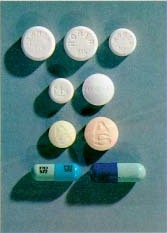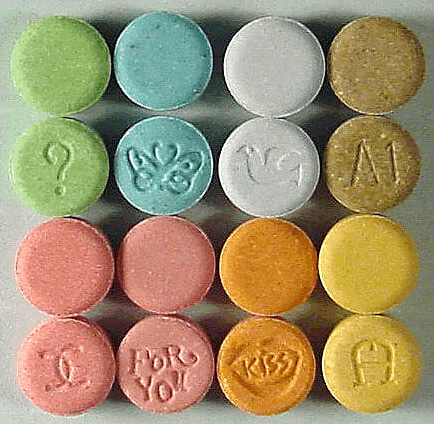|
Quaaludes
Methaqualone is a hypnotic sedative. It was sold under the brand names Quaalude ( ) and Sopor among others, which contained 300 mg of methaqualone, and sold as a combination drug under the brand name Mandrax, which contained 250 mg methaqualone and 25 mg diphenhydramine within the same tablet, mostly in Europe. Commercial production of methaqualone was halted in the mid-1980s due to widespread abuse and addictiveness. It is a member of the quinazolinone class. The sedative–hypnotic activity of methaqualone was first noted in 1955. In 1962, methaqualone was patented in the United States by Wallace and Tiernan. Its use peaked in the early 1970s for the treatment of insomnia, and as a sedative and muscle relaxant. Methaqualone became increasingly popular as a recreational drug and club drug in the late 1960s and 1970s, known variously as "ludes" or "disco biscuits" due to its widespread use during the popularity of disco in the 1970s, or "sopers" (also "soaps") ... [...More Info...] [...Related Items...] OR: [Wikipedia] [Google] [Baidu] |
Club Drug
Club drugs, also called rave drugs or party drugs, are a loosely defined category of recreational drugs which are associated with discothèques in the 1970s and nightclubs, dance clubs, electronic dance music (EDM) parties, and raves in the 1980s to today. Unlike many other categories, such as opiates and benzodiazepines, which are established according to pharmaceutical or chemical properties, club drugs are a "category of convenience", in which drugs are included due to the locations they are consumed and/or where the user goes while under the influence of the drugs. Club drugs are generally used by adolescents and young adults. This group of drugs is also called "designer drugs", as most are synthesized in a chemical lab (e.g., MDMA, ketamine, LSD) rather than being sourced from plants (as with marijuana, which comes from the cannabis plant) or opiates (which are naturally derived from the opium poppy). Club drugs range from entactogens such as MDMA ("ecstasy"), 2C-B ("nexus" ... [...More Info...] [...Related Items...] OR: [Wikipedia] [Google] [Baidu] |
Recreational Drug Use
Recreational drug use indicates the use of one or more psychoactive drugs to induce an altered state of consciousness either for pleasure or for some other casual purpose or pastime by modifying the perceptions and emotions of the user. When a psychoactive drug enters the user's body, it induces an intoxicating effect. Generally, recreational drugs are divided into three categories: depressants (drugs that induce a feeling of relaxation and calmness); stimulants (drugs that induce a sense of energy and alertness); and hallucinogens (drugs that induce perceptual distortions such as hallucination). In popular practice, recreational drug use generally is a tolerated social behaviour, rather than perceived as the medical condition of self-medication. However, heavy use of some drugs is socially stigmatized. Many people also use prescribed and controlled depressants such as opioids, as well as opiates and benzodiazepines. Common recreational drugs include caffeine, commonly ... [...More Info...] [...Related Items...] OR: [Wikipedia] [Google] [Baidu] |
Disco
Disco is a genre of dance music and a subculture that emerged in the 1970s from the United States' urban nightlife scene. Its sound is typified by four-on-the-floor beats, syncopated basslines, string sections, brass and horns, electric piano, synthesizers, and electric rhythm guitars. Disco started as a mixture of music from venues popular with Italian Americans, Hispanic and Latino Americans and Black Americans "'Broadly speaking, the typical New York discothèque DJ is young (between 18 and 30) and Italian,' journalist Vince Lettie declared in 1975. ..Remarkably, almost all of the important early DJs were of Italian extraction .. Italian Americans have played a significant role in America's dance music culture .. While Italian Americans mostly from Brooklyn largely created disco from scratch .." in Philadelphia and New York City during the late 1960s and early 1970s. Disco can be seen as a reaction by the 1960s counterculture to both the dominance of rock musi ... [...More Info...] [...Related Items...] OR: [Wikipedia] [Google] [Baidu] |
Death
Death is the irreversible cessation of all biological functions that sustain an organism. For organisms with a brain, death can also be defined as the irreversible cessation of functioning of the whole brain, including brainstem, and brain death is sometimes used as a legal definition of death. The remains of a former organism normally begin to decompose shortly after death. Death is an inevitable process that eventually occurs in almost all organisms. Death is generally applied to whole organisms; the similar process seen in individual components of an organism, such as cells or tissues, is necrosis. Something that is not considered an organism, such as a virus, can be physically destroyed but is not said to die. As of the early 21st century, over 150,000 humans die each day, with ageing being by far the most common cause of death. Many cultures and religions have the idea of an afterlife, and also may hold the idea of judgement of good and bad deeds in one's life ... [...More Info...] [...Related Items...] OR: [Wikipedia] [Google] [Baidu] |
Delirium
Delirium (also known as acute confusional state) is an organically caused decline from a previous baseline of mental function that develops over a short period of time, typically hours to days. Delirium is a syndrome encompassing disturbances in attention, consciousness, and cognition. It may also involve other neurological deficits, such as psychomotor disturbances (e.g. hyperactive, hypoactive, or mixed), impaired sleep-wake cycle, emotional disturbances, and perceptual disturbances (e.g. hallucinations and delusions), although these features are not required for diagnosis. Delirium is caused by an acute organic process, which is a physically identifiable structural, functional, or chemical problem in the brain that may arise from a disease process ''outside'' the brain that nonetheless affects the brain. It may result from an underlying disease process (e.g. infection, hypoxia), side effect of a medication, withdrawal from drugs, over-consumption of alcohol, usage of ... [...More Info...] [...Related Items...] OR: [Wikipedia] [Google] [Baidu] |
Convulsion
A convulsion is a medical condition where the body muscles contract and relax rapidly and repeatedly, resulting in uncontrolled shaking. Because epileptic seizures typically include convulsions, the term ''convulsion'' is sometimes used as a synonym for ''seizure''. However, not all epileptic seizures lead to convulsions, and not all convulsions are caused by epileptic seizures. Convulsions are also consistent with an electric shock and improper enriched air scuba diving. Non-epileptic convulsions have no relation with epilepsy, and are caused by non-epileptic seizures. Convulsion is a common term generally describing uncontrollable muscle contractions. The term convulsion has been used interchangeably with the word "seizure". Seizures may cause a person to have convulsions, but this is not always the case. Convulsion is a type of seizure that involves bursts of electrical activity in the brain. Occasionally the reason for a convulsion is unfamiliar. A convulsion may be caus ... [...More Info...] [...Related Items...] OR: [Wikipedia] [Google] [Baidu] |
Hypertonia
Hypertonia is a term sometimes used synonymously with spasticity and rigidity in the literature surrounding damage to the central nervous system, namely upper motor neuron lesions. Impaired ability of damaged motor neurons to regulate descending pathways gives rise to disordered spinal reflexes, increased excitability of muscle spindles, and decreased synaptic inhibition. These consequences result in abnormally increased muscle tone of symptomatic muscles. Some authors suggest that the current definition for spasticity, the velocity-dependent over-activity of the stretch reflex, is not sufficient as it fails to take into account patients exhibiting increased muscle tone in the absence of stretch reflex over-activity. They instead suggest that "reversible hypertonia" is more appropriate and represents a treatable condition that is responsive to various therapy modalities like drug and/or physical therapy. Presentation Symptoms associated with central nervous systems disorders ar ... [...More Info...] [...Related Items...] OR: [Wikipedia] [Google] [Baidu] |
Hyperreflexia
Hyperreflexia is overactive or overresponsive bodily reflexes. Examples of this include twitching and spastic tendencies, which indicate upper disease of the upper motor neurons and the lessening or loss of control ordinarily exerted by higher brain centers of lower neural pathways (disinhibition). The most common cause of hyperreflexia is spinal-cord injury (''see'' "Autonomic dysreflexia"). Standard stimuli, such as the filling of the bladder, can cause excessive responses from the nervous system; the causes are not known. Hyperreflexia also has many other causes, including the side effects of drugs and stimulants; hyperthyroidism; electrolyte imbalance; serotonin syndrome; severe brain trauma; multiple sclerosis; Reye syndrome; and preeclampsia. Treatment depends on the cause of the hyperreflexia. If drugs cause it, treatment may require that they not be used. Recovery from hyperreflexia can occur several hours to several months after a spinal-cord injury; the phase of ... [...More Info...] [...Related Items...] OR: [Wikipedia] [Google] [Baidu] |
Hypnotic
Hypnotic (from Greek ''Hypnos'', sleep), or soporific drugs, commonly known as sleeping pills, are a class of (and umbrella term for) psychoactive drugs whose primary function is to induce sleep (or surgical anesthesiaWhen used in anesthesia to produce and maintain unconsciousness, "sleep" is metaphorical as there are no regular sleep stages or cyclical natural states; patients rarely recover from anesthesia feeling refreshed and with renewed energy. The word is also used in art.) and to treat insomnia (sleeplessness). This group of drugs is related to sedatives''. ''Whereas the term sedative describes drugs that serve to calm or relieve anxiety, the term hypnotic generally describes drugs whose main purpose is to initiate, sustain, or lengthen sleep. Because these two functions frequently overlap, and because drugs in this class generally produce dose-dependent effects (ranging from anxiolysis to loss of consciousness), they are often referred to collectively as sedative- ... [...More Info...] [...Related Items...] OR: [Wikipedia] [Google] [Baidu] |
Drug Overdose
A drug overdose (overdose or OD) is the ingestion or application of a drug or other substance in quantities much greater than are recommended.Definitions Retrieved on 20 September 2014."Stairway to Recovery: Glossary of Terms" . Retrieved on 19 March 2021 Typically it is used for cases when a risk to health will potentially result. An overdose may result in a toxic state or . Classification [...More Info...] [...Related Items...] OR: [Wikipedia] [Google] [Baidu] |
Vomiting
Vomiting (also known as emesis and throwing up) is the involuntary, forceful expulsion of the contents of one's stomach through the mouth and sometimes the nose. Vomiting can be the result of ailments like food poisoning, gastroenteritis, pregnancy, motion sickness, or hangover; or it can be an after effect of diseases such as brain tumors, elevated intracranial pressure, or overexposure to ionizing radiation. The feeling that one is about to vomit is called nausea; it often precedes, but does not always lead to vomiting. Impairment due to alcohol or anesthesia can cause inhalation of vomit, leading to suffocation. In severe cases, where dehydration develops, intravenous fluid may be required. Antiemetics are sometimes necessary to suppress nausea and vomiting. Self-induced vomiting can be a component of an eating disorder such as bulimia, and is itself now classified as an eating disorder on its own, purging disorder. Complications Aspiration Vomiting is dangerou ... [...More Info...] [...Related Items...] OR: [Wikipedia] [Google] [Baidu] |
Kidney Failure
Kidney failure, also known as end-stage kidney disease, is a medical condition in which the kidneys can no longer adequately filter waste products from the blood, functioning at less than 15% of normal levels. Kidney failure is classified as either acute kidney failure, which develops rapidly and may resolve; and chronic kidney failure, which develops slowly and can often be irreversible. Symptoms may include leg swelling, feeling tired, vomiting, loss of appetite, and confusion. Complications of acute and chronic failure include uremia, high blood potassium, and volume overload. Complications of chronic failure also include heart disease, high blood pressure, and anemia. Causes of acute kidney failure include low blood pressure, blockage of the urinary tract, certain medications, muscle breakdown, and hemolytic uremic syndrome. Causes of chronic kidney failure include diabetes, high blood pressure, nephrotic syndrome, and polycystic kidney disease. Diagnosis of acute f ... [...More Info...] [...Related Items...] OR: [Wikipedia] [Google] [Baidu] |





